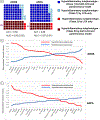Host-Response Subphenotypes Offer Prognostic Enrichment in Patients With or at Risk for Acute Respiratory Distress Syndrome
- PMID: 31634231
- PMCID: PMC6865808
- DOI: 10.1097/CCM.0000000000004018
Host-Response Subphenotypes Offer Prognostic Enrichment in Patients With or at Risk for Acute Respiratory Distress Syndrome
Abstract
Objectives: Classification of patients with acute respiratory distress syndrome into hyper- and hypoinflammatory subphenotypes using plasma biomarkers may facilitate more effective targeted therapy. We examined whether established subphenotypes are present not only in patients with acute respiratory distress syndrome but also in patients at risk for acute respiratory distress syndrome (ARFA) and then assessed the prognostic information of baseline subphenotyping on the evolution of host-response biomarkers and clinical outcomes.
Design: Prospective, observational cohort study.
Setting: Medical ICU at a tertiary academic medical center.
Patients: Mechanically ventilated patients with acute respiratory distress syndrome or ARFA.
Interventions: None.
Measurements and main results: We performed longitudinal measurements of 10 plasma biomarkers of host injury and inflammation. We applied unsupervised latent class analysis methods utilizing baseline clinical and biomarker variables and demonstrated that two-class models (hyper- vs hypoinflammatory subphenotypes) offered improved fit compared with one-class models in both patients with acute respiratory distress syndrome and ARFA. Baseline assignment to the hyperinflammatory subphenotype (39/104 [38%] acute respiratory distress syndrome and 30/108 [28%] ARFA patients) was associated with higher severity of illness by Sequential Organ Failure Assessment scores and incidence of acute kidney injury in patients with acute respiratory distress syndrome, as well as higher 30-day mortality and longer duration of mechanical ventilation in ARFA patients (p < 0.0001). Hyperinflammatory patients exhibited persistent elevation of biomarkers of innate immunity for up to 2 weeks postintubation.
Conclusions: Our results suggest that two distinct subphenotypes are present not only in patients with established acute respiratory distress syndrome but also in patients at risk for its development. Hyperinflammatory classification at baseline is associated with higher severity of illness, worse clinical outcomes, and trajectories of persistently elevated biomarkers of host injury and inflammation during acute critical illness compared with hypoinflammatory patients. Our findings provide strong rationale for examining treatment effect modifications by subphenotypes in randomized clinical trials to inform precision therapeutic approaches in critical care.
Conflict of interest statement
Conflicts of Interest: The other authors have no conflicts of interest to declare.
Figures



Comment in
-
The Challenge and the Promise of Identifying More Homogeneous Subgroups in Acute Respiratory Distress Syndrome.Crit Care Med. 2019 Dec;47(12):1806-1808. doi: 10.1097/CCM.0000000000004059. Crit Care Med. 2019. PMID: 31738249 No abstract available.
References
-
- Matthay MA, McAuley DF, Ware LB: Clinical trials in acute respiratory distress syndrome: challenges and opportunities. Lancet Respir Med 2017; 5:524–534 - PubMed
-
- Gotts JE, Matthay MA: Sepsis: pathophysiology and clinical management. BMJ 2016; 353:i1585. - PubMed
-
- Shankar-Hari M, Fan E, Ferguson ND: Acute respiratory distress syndrome (ARDS) phenotyping. Intensive Care Med 2018; - PubMed
Publication types
MeSH terms
Substances
Grants and funding
- K24 HL123342/HL/NHLBI NIH HHS/United States
- R01 LM012087/LM/NLM NIH HHS/United States
- R01 HL097376/HL/NHLBI NIH HHS/United States
- R01 HL116472/HL/NHLBI NIH HHS/United States
- K24 HL143285/HL/NHLBI NIH HHS/United States
- R01 HL136143/HL/NHLBI NIH HHS/United States
- R01 HL142084/HL/NHLBI NIH HHS/United States
- R01 HL096376/HL/NHLBI NIH HHS/United States
- U01 HL137159/HL/NHLBI NIH HHS/United States
- U01 HL098962/HL/NHLBI NIH HHS/United States
- K23 GM122069/GM/NIGMS NIH HHS/United States
- R01 HL133184/HL/NHLBI NIH HHS/United States
- F32 HL137258/HL/NHLBI NIH HHS/United States
- L30 HL143734/HL/NHLBI NIH HHS/United States
- K23 HL139987/HL/NHLBI NIH HHS/United States
- P01 HL114453/HL/NHLBI NIH HHS/United States
- F32 HL142172/HL/NHLBI NIH HHS/United States
- R35 HL139860/HL/NHLBI NIH HHS/United States
- K08 HS025455/HS/AHRQ HHS/United States
LinkOut - more resources
Full Text Sources

